Retail Areas
-
- Five Minutes With Tomas Tillberg Maritime Reporter, Feb 2014 #30
Modern cruise ships can cost upwards of a billion and built to last more than 25 years, so the platforms must be built for change, as evolving style & taste, material innovation & maritime regulation dictate. “Built to stand the test of time” is the mantra, so in seeking insight on modern cruise design we sought insights from a designer that also has stood the test of time, Tomas Tillberg of Tillberg Design International.
Mr. Tillberg, as a long-tenured and well-respected member of the Cruise Ship design community, put in perspective the overriding design trends that you have seen in cruise ships over the last decade?
There are more diverse and better defined cruise ship designs today than 10 years ago and there is more attention to intimacy, variety, options and multiple functions in the designs than ever before.
One reason is that there are more cruise lines catering to better and better defined segments of the cruise market, which means the designs have to be more conscious of the different brands and how they are marketed, a wonderful challenge for us as a design firm.
The itineraries are also more diverse than before and present interesting choices for the passenger that were non-existent 10 years ago. As one of the factors considered when designing the interiors of a cruise ship is the itinerary this too presents new and exciting challenges for us.
Cruise lines have always been looking for new potential revenue sources. The retail areas have been an important one of those and have developed considerably during the last 10 years as have casinos and food venues. There are more restaurants with different food choices than ever before. The designs have to reflect this, so today we design Asian food venues as well as the very best French or a casual Italian “Eataly” or even a fully authentic Moorish Café.
There is a trend to introduce what you can find on land also on the ship such as the Central Park on the RCCL ships or different amusements or sports activities. Also the ship can actually be a destination today rather than a means of travel. Today families with children of all ages are an important part of the guests of many cruise lines and large areas on ships are devoted to these different age groups.
Technology has moved forward at a rapid rate and today we see wireless communication as a natural part of the experience on a cruise. This means that areas such as the business center tend to diminish in importance as the guests are able to use their laptops, iPads or phones for emails, Skype etc. anywhere on the ship.
To summarize, the trend is towards more of a boutique hotel atmosphere and residential feeling, multiple choices in itineraries, level of comfort and luxury, food and entertainment and basically more bang for the buck!
What, today, do you see as the defining design trends?
The design is more understated, contemporary and timeless. Our challenge is to take the design to the next level, thinking ahead of current design trends.
What are the hot trends today in regards to interior design, as far as accommodation, public and entertainment spaces?
In accommodations, cabins are larger, closer to hotel accommodations with improved bedding (mattresses are important). The design of the bathrooms has improved. In public spaces it’s more about diversity; smaller areas and more choices. Regarding entertainment spaces, the level of entertainment has increased, sometimes to Broadway quality and the designs of the entertainment venues have to be equally creative.
Can you provide an overview of the projects that you are currently involved?
We are working for all the major cruise lines on newbuilding, revitalization and refit projects and are currently designing cabins and public areas as well as crew areas.
Technology is a recurring theme in our pages: what technologies, or evolution of technologies, has in your opinion had the most dramatic impact on the design of cruise ships, and why?
The fast development of wireless technology has meant a re-thinking of the designs of several types of areas. The constant development of new materials also impacts our designs. An example of this is the Trevira CS fiber. It is inherently inflammable and the diversity of textiles manufactured today with this fiber is astonishing.
You are involved in an industry which designs assets that are expected to remain functional and attractive for decades, while serving an ever-evolving consumer base. What is the secret, in your estimation, to your (or anyone’s) long term success?
To have an active interest in our clients, to be open and receptive and understand the specific brand identity. There is also a familiarity with what is desired that comes from experience. A sense of practicality in choosing materials and designs that will last is also necessary as well as having an understanding for the economy and the cost of the designs.
Personally, professionally, what do you count as the greatest influences to your ship design style, and why?
We ultimately design for the passenger, which means that we have to be very attentive and understand really well who our client is planning to market the ship to. It makes each project an exciting challenge in its own right. Experience is of course an important part of design, the lessons learned help us stay real and meet budgetary expectations for example, but there is actually not so much influence from the past, it’s happening right now and with each ongoing project. Our goal is to stay ahead of the game and to design for tomorrow.
If you had to pick one cruise ship of all time that is your hands-down favorite, which ship is it and why?
The next one! -
- PHOENIX WORLD CITY: Billion-Dollar Ship Project Takes Shape At Avondale Maritime Reporter, Sep 1990 #18
within the port to the World City Corporation. Development plans to complement the ship include several hotels, recreational, entertainment and retail areas, a world space center, and an office, meeting and convention complex. Ron McAlear, Avondale's Phoenix World City project team leader, said:
-
 )
March 2024 - Marine Technology Reporter page: 37
)
March 2024 - Marine Technology Reporter page: 37miscible barrier ? uid heavier than seawater (sg=1.026) and lighter than the battery electrolyte (sg=1.265). The original cell vent cap was screwed into the top of the riser pipe to vent the gases associated with charging. Wires were soldered to the lead (Pb) posts. The lead-acid battery was additionall
-
 )
March 2024 - Marine Technology Reporter page: 25
)
March 2024 - Marine Technology Reporter page: 25Auerbach explained that ideally, “one ? ed layers of geothermal activity,” noted changes over an area of 8,000 km2. They would have both instruments: seismom- Skett, “and the change in salinity and dis- found up to seven km3 of displaced ma- eters to detect and locate subsurface ac- solved particles for
-
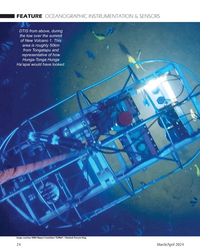 )
March 2024 - Marine Technology Reporter page: 24
)
March 2024 - Marine Technology Reporter page: 24FEATURE OCEANOGRAPHIC INSTRUMENTATION & SENSORS DTIS from above, during the tow over the summit of New Volcano 1. This area is roughly 50km from Tongatapu and representative of how Hunga-Tonga Hunga Ha’apai would have looked. Image courtesy NIWA-Nippon Foundation TESMaP / Rebekah Parsons-King 24
-
 )
March 2024 - Marine Technology Reporter page: 19
)
March 2024 - Marine Technology Reporter page: 19About the Author vey with the pipe tracker is not required, resulting in signi? - Svenn Magen Wigen is a Cathodic Protection and corrosion control cant cost savings, mainly related to vessel charter. expert having worked across The major advantage of using FiGS on any type of subsea engineering, design
-
 )
March 2024 - Marine Technology Reporter page: 15
)
March 2024 - Marine Technology Reporter page: 15sensor options for longer mission periods. About the Author For glider users working in ? sheries and conservation, Shea Quinn is the Product Line Manager the Sentinel can run several high-energy passive and active of the Slocum Glider at Teledyne Webb acoustic sensors, on-board processing, and imaging
-
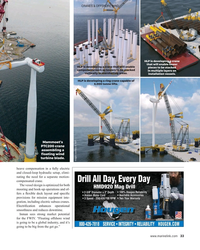 )
April 2024 - Maritime Reporter and Engineering News page: 33
)
April 2024 - Maritime Reporter and Engineering News page: 33CRANES & OFFSHORE WIND HLP is developing a crane that will enable tower HLP is developing a crane that will enable pieces to be stacked components such as towers to be stacked in multiple layers on vertically in marshalling areas. installation vessels. HLP is developing a ring crane capable of 6
-
 )
April 2024 - Maritime Reporter and Engineering News page: 32
)
April 2024 - Maritime Reporter and Engineering News page: 32FEATURE A closeup of a blade installation process taken via drone. A blade handling system is apparent (in yellow). Images courtesy of Mammoet requirement for the development of these cranes, particularly ling area. This would result in a major time and fuel saving. in ? oating offshore wind,” says
-
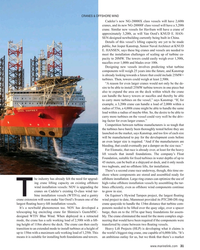 )
April 2024 - Maritime Reporter and Engineering News page: 31
)
April 2024 - Maritime Reporter and Engineering News page: 31CRANES & OFFSHORE WIND Cadeler’s new NG-20000X class vessels will have 2,600t cranes, and its new NG-20000F class vessel will have a 3,200t crane. Similar new vessels for Havfram will have a crane of approximately 3,200t, as will Van Oord’s KNUD E. HAN- SEN-designed newbuilding currently being built in
-
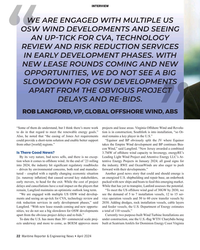 )
April 2024 - Maritime Reporter and Engineering News page: 22
)
April 2024 - Maritime Reporter and Engineering News page: 22INTERVIEW WE ARE ENGAGED WITH MULTIPLE US OSW WIND DEVELOPMENTS AND SEEING AN UP-TICK FOR CVA, TECHNOLOGY REVIEW AND RISK REDUCTION SERVICES IN EARLY DEVELOPMENT PHASES. WITH NEW LEASE ROUNDS COMING AND NEW OPPORTUNITIES, WE DO NOT SEE A BIG SLOWDOWN FOR OSW DEVELOPMENTS APART FROM THE OBVIOUS
-
 )
April 2024 - Maritime Reporter and Engineering News page: 16
)
April 2024 - Maritime Reporter and Engineering News page: 16MARKETS SOVs – Analyzing Current, Future Demand Drivers By Philip Lewis, Director of Research, Intelatus © Björn Wylezich/AdobeStock t a high-level, there are three solutions to transferring Lower day rate CTVs are often used for daily transfer of technicians from shore bases to offshore wind farms
-
 )
April 2024 - Maritime Reporter and Engineering News page: 15
)
April 2024 - Maritime Reporter and Engineering News page: 15hydro-acoustic design of a propulsor that delays cavitation meets its underwater noise limits. This will require specialized inception and cavitating area. The third approach should be test sites or specialized mobile underwater testing equipment. isolation mounting of a vibro-active equipment and
-
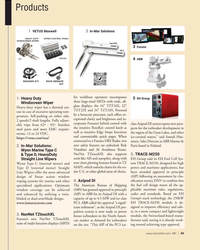 )
April 2024 - Marine News page: 43
)
April 2024 - Marine News page: 43Products 1 2 VETUS Maxwell In-Mar Solutions 3 Furuno ABB 4 for workboat operators encompasses EH Group 1. Heavy Duty 5 three large-sized MFDs with wide, all- Windscreen Wiper glass displays: the 16” TZT16X, 22” Heavy-duty wiper has a thermal cut- TZT22X and 24” TZT24X. Powered out in
-
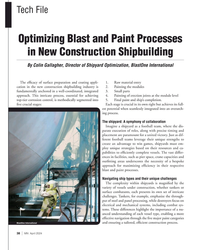 )
April 2024 - Marine News page: 38
)
April 2024 - Marine News page: 38Tech File Optimizing Blast and Paint Processes in New Construction Shipbuilding By Colin Gallagher, Director of Shipyard Optimization, BlastOne International The ef? cacy of surface preparation and coating appli- 1. Raw material entry cation in the new construction shipbuilding industry is 2. Painting
-
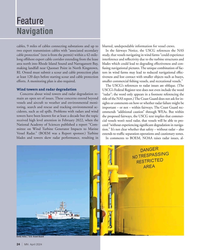 )
April 2024 - Marine News page: 24
)
April 2024 - Marine News page: 24Feature Navigation cables, 9 miles of cables connecting substations and up to blurred, undependable information for vessel crews. two export transmission cables with “associated secondary In the fairways Notice, the USCG references the NAS cable protection” (text is from the permit) within a 42-mile-
-
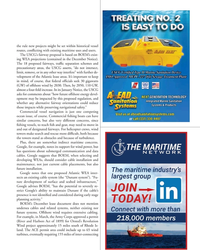 )
April 2024 - Marine News page: 23
)
April 2024 - Marine News page: 23the rule new projects might be set within historical vessel routes, con? icting with existing maritime uses and users. The USCG’s fairway proposal is based on BOEM’s exist- ing WEA projections (contained in the December Notice). The 18 proposed fairways, traf? c separation schemes and precautionary
-
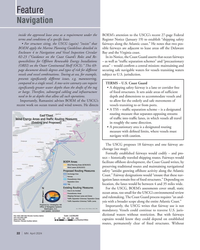 )
April 2024 - Marine News page: 22
)
April 2024 - Marine News page: 22Feature Navigation inside the approved lease area as a requirement under the BOEM’s attention to the USCG’s recent 27-page Federal terms and conditions of a speci? c lease. Register Notice (January 19) to establish “shipping safety • For structure siting, the USCG (again) “insists” that fairways along
-
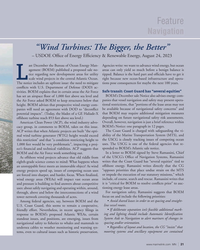 )
April 2024 - Marine News page: 21
)
April 2024 - Marine News page: 21Feature Navigation “Wind Turbines: The Bigger, the Better” – USDOE Of? ce of Energy Ef? ciency & Renewable Energy, August 24, 2023 ast December the Bureau of Ocean Energy Man- Agencies write: we want to advance wind energy, but ocean agement (BOEM) published a proposed sale no- areas can only yield so
-
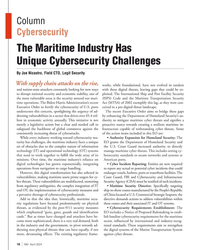 )
April 2024 - Marine News page: 18
)
April 2024 - Marine News page: 18Column Cybersecurity The Maritime Industry Has Unique Cybersecurity Challenges By Joe Nicastro, Field CTO, Legit Security With supply chain attacks on the rise, works, while foundational, have not evolved in tandem and nation-state attackers constantly looking for new ways with these digital threats
-
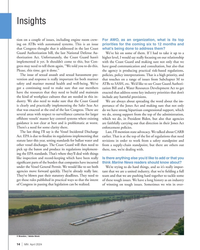 )
April 2024 - Marine News page: 14
)
April 2024 - Marine News page: 14Insights tion on a couple of issues, including engine room crew- For AWO, as an organization, what is its top ing on ATBs with automated systems. This is an issue priorities for the coming six to 12 months and that Congress thought that it addressed in the last Coast what’s being done to address them? Gua
-
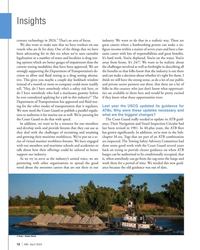 )
April 2024 - Marine News page: 12
)
April 2024 - Marine News page: 12Insights century technology in 2024.” That’s an area of focus. industry. We want to do that in a realistic way. These are We also want to make sure that we have workers on our great careers where a hardworking person can make a six- vessels who are ? t for duty. One of the things that we have ? gure
-
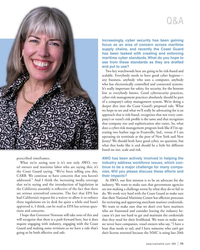 )
April 2024 - Marine News page: 11
)
April 2024 - Marine News page: 11Q&A Increasingly, cyber security has been gaining focus as an area of concern across maritime supply chains, and recently the Coast Guard has been tasked with creating and enforcing maritime cyber standards. What do you hope to see from these standards as they are drafted and put to use? Two key
-
 )
February 2024 - Maritime Reporter and Engineering News page: 44
)
February 2024 - Maritime Reporter and Engineering News page: 44Tech Files Latest Products & Technologies MarineShaft Yanmar Hydrogen MarineShaft specializes in urgent re- Fuel Cell AIP pair/replacement of damaged rudder and Yanmar Power Technology Co., Ltd. propeller equipment along with many (Yanmar PT), a subsidiary of Yanmar on-site repair services. MarineShaft
-
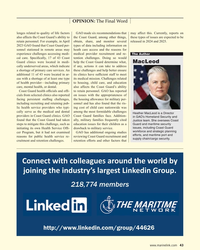 )
February 2024 - Maritime Reporter and Engineering News page: 43
)
February 2024 - Maritime Reporter and Engineering News page: 43OPINION: The Final Word lenges related to quality of life factors GAO made six recommendations that may affect this. Currently, reports on also affects the Coast Guard’s ability to the Coast Guard, among other things, these types of issues are expected to be retain personnel. For example, in April
-
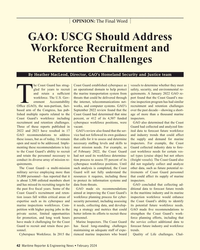 )
February 2024 - Maritime Reporter and Engineering News page: 42
)
February 2024 - Maritime Reporter and Engineering News page: 42OPINION: The Final Word GAO: USCG Should Address Workforce Recruitment and Retention Challenges By Heather MacLeod, Director, GAO’s Homeland Security and Justice team he Coast Guard has strug- Coast Guard established cyberspace as vessels to determine whether they meet gled for years to recruit an
